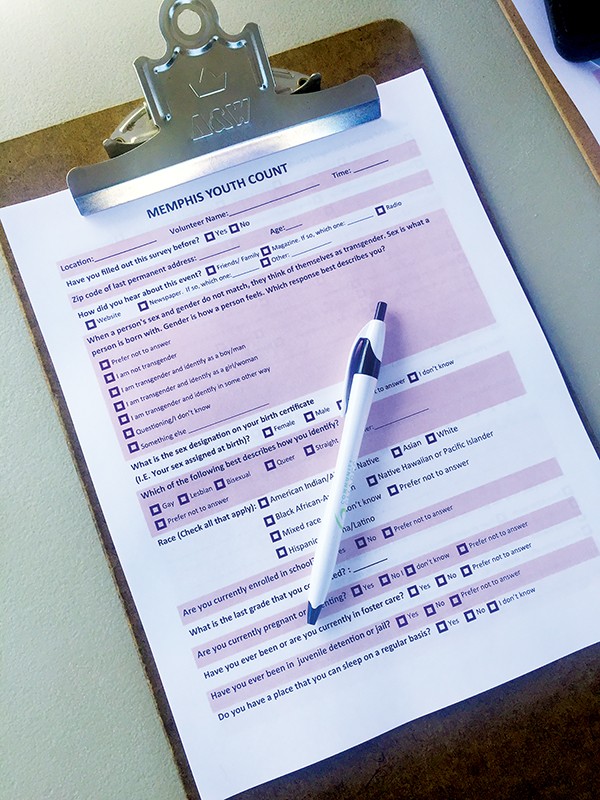On a national scale, around 40 percent of homeless youth identify as lesbian, gay, bisexual, or transgender (LGBT), according to the United States Interagency Council on Homelessness.
The Memphis Gay and Lesbian Community Center (MGLCC) set out last weekend to find out how many local LGBT youth are homeless. Through its first annual Youth Count, volunteers stationed across the city surveyed teens and young adults about their housing situations and their sexual orientation and gender identity.
The exact number of homeless youth identified from the point-in-time count wasn’t yet available at press time, but the MGLCC could confim that they surveyed more than 100 youth.
“This is us trying to figure out how we get our kids off the street,” said Will Batts, executive director of the MGLCC. “It’s not safe for them to be on the street. It’s not healthy. It’s not good for their long-term outcomes. To do that, we need to know how many of them are there at any one time.”

Batts said the center is working on a permanent solution to help LGBT homeless youth ages 18 to 25, but he said the center won’t announce specifics until December. He said homeless LGBT teens and young adults in Memphis who have aged out of the foster care system have few options.
“We don’t refer kids to the shelters anymore because so many kids have reported being sexually assaulted or having their things stolen. A couple kids have said they fell asleep in the shelter with their arms wrapped around their belongings and woke up with them gone,” Batts said. “There’s nothing safe about those places for young people. They’re not safe for skinny little gay kids, and they’re certainly not safe for trans kids.”
Because the shelters have a reputation as unsafe places for LGBT youth, Batts said many turn to other options, some of which may dangerous or illegal.
“Some kids will turn to couch-surfing if it’s available. But others adapt survival techniques of selling themselves to get money to eat. An 18-year-old kid should not have to do that to survive,” Batts said.
Stephanie Reyes, MGLCC’s youth services and volunteer manager, said the center started their Youth Count by surveying those who showed up at the center’s weekly Gen Q youth group for LGBT young adults on Friday. On Saturday, volunteers set up tables at various locations around town where youth might hang out — Tobey Skate Park, the Central Library, Social Suds laundromat in South Memphis, etc. — and surveyed any young people who appeared to be under the age of 25.
The survey asks questions about sexual orientation and homelessness, so some surveyed likely weren’t the target population.
“We don’t want to stigmatize the kids and say, hey, ‘You look queer, come fill this out,'” Batts said. “They just wanted anybody under 25 to fill it out, and then they’ll pull out the ones that identify as LGBT.”
Reyes says she hopes having some solid numbers will help them raise funds for the center’s goal of housing LGBT homeless youth. For now, she says when homeless youth come to the center, she can provide food, clothing, and help with resumes, but she has no options for shelter.
“There are no shelters in Memphis that advertise that they are LGBT-friendly. Most are faith-based, and I don’t know of any that are, like, ‘Bring on the trans kids,'” Reyes said. “If you have an 18-year-old who has aged out of foster care, and they come to the center and tell us they’re homeless and ask what they can do, all I can say is go to the Union Mission and don’t tell anyone that you’re gay.”
In a separate MGLCC project, Reyes is launching a survey of emergency homeless shelters to determine which would like help in becoming more LGBT-friendly.
“It may be a case where the shelter may not be against this community, but they may not know how to serve them properly or be respectful in their questions. We want to find out who has had sensitivity trainings or who has an intake form that asks your identity instead of just male and female sex,” Reyes said.
Several years ago, the MGLCC launched a foster program that paired homeless LGBT youth with volunteers willing to temporarily open their homes. But that program is no longer in place.
“Some of the kids had more serious issues than most people could deal with. There are mental health issues and legal issues,” Batts said.
He said the center’s future efforts to house homeless youth will include wraparound services for legal, medical, and mental health needs.
“We make up less than 10 percent of the population, but up to 40 percent of homeless kids identify as LGBT. I saw a report today that said 40 percent of girls in juvenile detention facilities identify as LGBT,” Batts said. “Our community is overrepresented in homelessness and incarceration and abuse. But it’s not because we’re bad people. It’s because there’s a society that has told us that we are bad and disordered, and that wears on people. It creates a really unhealthy environment for young people.”